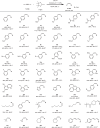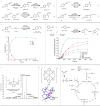Cobalt catalyzed practical hydroboration of terminal alkynes with time-dependent stereoselectivity
- PMID: 38467660
- PMCID: PMC10928171
- DOI: 10.1038/s41467-024-46550-y
Cobalt catalyzed practical hydroboration of terminal alkynes with time-dependent stereoselectivity
Abstract
Stereodefined vinylboron compounds are important organic synthons. The synthesis of E-1-vinylboron compounds typically involves the addition of a B-H bond to terminal alkynes. The selective generation of the thermodynamically unfavorable Z-isomers remains challenging, necessitating improved methods. Here, such a proficient and cost-effective catalytic system is introduced, comprising a cobalt salt and a readily accessible air-stable CNC pincer ligand. This system enables the transformation of terminal alkynes, even in the presence of bulky substituents, with excellent Z-selectivity. High turnover numbers (>1,600) and turnover frequencies (>132,000 h-1) are achieved at room temperature, and the reaction can be scaled up to 30 mmol smoothly. Kinetic studies reveal a formal second-order dependence on cobalt concentration. Mechanistic investigations indicate that the alkynes exhibit a higher affinity for the catalyst than the alkene products, resulting in exceptional Z-selective performance. Furthermore, a rare time-dependent stereoselectivity is observed, allowing for quantitative conversion of Z-vinylboronate esters to the E-isomers.
© 2024. The Author(s).
Conflict of interest statement
The authors declare no competing interests.
Figures





Similar articles
-
Cobalt catalyzed z-selective hydroboration of terminal alkynes and elucidation of the origin of selectivity.J Am Chem Soc. 2015 May 13;137(18):5855-8. doi: 10.1021/jacs.5b00936. Epub 2015 Apr 29. J Am Chem Soc. 2015. PMID: 25884604
-
Ruthenium-Catalyzed (Z)-Selective Hydroboration of Terminal Alkynes with Naphthalene-1,8-diaminatoborane.J Am Chem Soc. 2019 Oct 30;141(43):17042-17047. doi: 10.1021/jacs.9b06910. Epub 2019 Sep 18. J Am Chem Soc. 2019. PMID: 31523958
-
Z-selective alkene isomerization by high-spin cobalt(II) complexes.J Am Chem Soc. 2014 Jan 22;136(3):945-55. doi: 10.1021/ja408238n. Epub 2014 Jan 3. J Am Chem Soc. 2014. PMID: 24386941
-
(Z)-Selective Hydrosilylation and Hydroboration of Terminal Alkynes Enabled by Ruthenium Complexes with an N-Heterocyclic Carbene Ligand.Chem Rec. 2021 Dec;21(12):3429-3441. doi: 10.1002/tcr.202100083. Epub 2021 May 24. Chem Rec. 2021. PMID: 34028185 Review.
-
The reaction of singlet oxygen with enecarbamates: a mechanistic playground for investigating chemoselectivity, stereoselectivity, and vibratioselectivity of photooxidations.Acc Chem Res. 2008 Mar;41(3):387-400. doi: 10.1021/ar7001254. Epub 2008 Feb 13. Acc Chem Res. 2008. PMID: 18269252 Review.
Cited by
-
A manganese(I) complex with a 190 ns metal-to-ligand charge transfer lifetime.Nat Commun. 2025 Aug 22;16(1):7850. doi: 10.1038/s41467-025-63225-4. Nat Commun. 2025. PMID: 40846841 Free PMC article.
References
-
- Miyaura N, Suzuki A. Palladium-catalyzed cross-coupling reactions of organoboron compounds. Chem. Rev. 1995;95:2457–2483. doi: 10.1021/cr00039a007. - DOI
-
- Yoshida H. Borylation of alkynes under base/coinage metal catalysis: some recent developments. ACS Catal. 2016;6:1799–1811. doi: 10.1021/acscatal.5b02973. - DOI
Grants and funding
LinkOut - more resources
Full Text Sources

